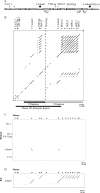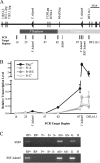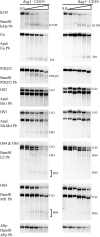The mouse immunoglobulin heavy chain V-D intergenic sequence contains insulators that may regulate ordered V(D)J recombination
- PMID: 20100833
- PMCID: PMC2843181
- DOI: 10.1074/jbc.M109.098251
The mouse immunoglobulin heavy chain V-D intergenic sequence contains insulators that may regulate ordered V(D)J recombination
Abstract
During immunoglobulin heavy chain (Igh) V(D)J recombination, D to J precedes V to DJ recombination in an ordered manner, controlled by differential chromatin accessibility of the V and DJ regions and essential for correct antibody assembly. However, with the exception of the intronic enhancer Emu, which regulates D to J recombination, cis-acting regulatory elements have not been identified. We have assembled the sequence of a strategically located 96-kb V-D intergenic region in the mouse Igh and analyzed its activity during lymphocyte development. We show that Emu-dependent D antisense transcription, proposed to open chromatin before D to J recombination, extends into the V-D region for more than 30 kb in B cells before, during, and after V(D)J recombination and in T cells but terminates 40 kb from the first V gene. Thus, subsequent V antisense transcription before V to DJ recombination is actively prevented and must be independently activated. To find cis-acting elements that regulate this differential chromatin opening, we identified six DNase I-hypersensitive sites (HSs) in the V-D region. One conserved HS upstream of the first D gene locally regulates D genes. Two further conserved HSs near the D region mark a sharp decrease in antisense transcription, and both HSs bind CTCF in vivo. Further, they both possess enhancer-blocking activity in vivo. Thus, we propose that they are enhancer-blocking insulators preventing Emu-dependent chromatin opening extending into the V region. Thus, they are the first elements identified that may control ordered V(D)J recombination and correct assembly of antibody genes.
Figures






Similar articles
-
Elements between the IgH variable (V) and diversity (D) clusters influence antisense transcription and lineage-specific V(D)J recombination.Proc Natl Acad Sci U S A. 2010 Dec 21;107(51):22207-12. doi: 10.1073/pnas.1015954107. Epub 2010 Dec 1. Proc Natl Acad Sci U S A. 2010. PMID: 21123744 Free PMC article.
-
Antisense intergenic transcription precedes Igh D-to-J recombination and is controlled by the intronic enhancer Emu.Mol Cell Biol. 2007 Aug;27(15):5523-33. doi: 10.1128/MCB.02407-06. Epub 2007 May 25. Mol Cell Biol. 2007. PMID: 17526723 Free PMC article.
-
Insertion of an imprinted insulator into the IgH locus reveals developmentally regulated, transcription-dependent control of V(D)J recombination.Mol Cell Biol. 2015 Feb;35(3):529-43. doi: 10.1128/MCB.00235-14. Epub 2014 Nov 17. Mol Cell Biol. 2015. PMID: 25403489 Free PMC article.
-
Large-scale chromatin remodeling at the immunoglobulin heavy chain locus: a paradigm for multigene regulation.Adv Exp Med Biol. 2009;650:59-72. doi: 10.1007/978-1-4419-0296-2_5. Adv Exp Med Biol. 2009. PMID: 19731801 Review.
-
Mechanism and control of V(D)J recombination at the immunoglobulin heavy chain locus.Annu Rev Immunol. 2006;24:541-70. doi: 10.1146/annurev.immunol.23.021704.115830. Annu Rev Immunol. 2006. PMID: 16551259 Review.
Cited by
-
Germline deletion of Igh 3' regulatory region elements hs 5, 6, 7 (hs5-7) affects B cell-specific regulation, rearrangement, and insulation of the Igh locus.J Immunol. 2012 Mar 15;188(6):2556-66. doi: 10.4049/jimmunol.1102763. Epub 2012 Feb 17. J Immunol. 2012. PMID: 22345664 Free PMC article.
-
Elements between the IgH variable (V) and diversity (D) clusters influence antisense transcription and lineage-specific V(D)J recombination.Proc Natl Acad Sci U S A. 2010 Dec 21;107(51):22207-12. doi: 10.1073/pnas.1015954107. Epub 2010 Dec 1. Proc Natl Acad Sci U S A. 2010. PMID: 21123744 Free PMC article.
-
Interaction between the immunoglobulin heavy chain 3' regulatory region and the IgH transcription unit during B cell differentiation.Mol Immunol. 2011 Oct;49(1-2):297-303. doi: 10.1016/j.molimm.2011.08.024. Epub 2011 Sep 25. Mol Immunol. 2011. PMID: 21945019 Free PMC article.
-
Cohesin, CTCF and lymphocyte antigen receptor locus rearrangement.Trends Immunol. 2012 Apr;33(4):153-9. doi: 10.1016/j.it.2012.02.004. Epub 2012 Mar 20. Trends Immunol. 2012. PMID: 22440186 Free PMC article. Review.
-
Sequential activation and distinct functions for distal and proximal modules within the IgH 3' regulatory region.Proc Natl Acad Sci U S A. 2016 Feb 9;113(6):1618-23. doi: 10.1073/pnas.1514090113. Epub 2016 Feb 1. Proc Natl Acad Sci U S A. 2016. PMID: 26831080 Free PMC article.
References
Publication types
MeSH terms
Substances
Grants and funding
LinkOut - more resources
Full Text Sources
Other Literature Sources

